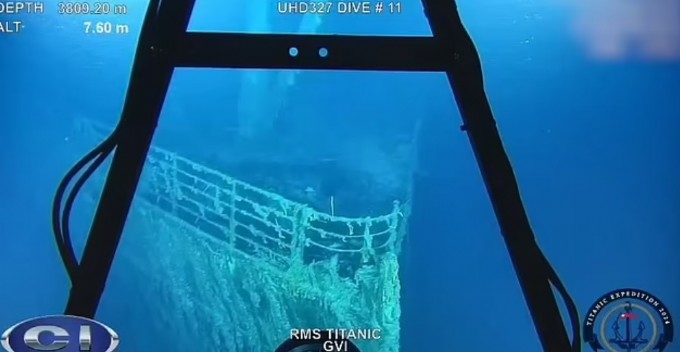Fabulous
Titanic's famous bow has remained just as recognisable
Titanic’s Iconic Bow Railing Collapses, Signaling Rapid Decay as Preservation Efforts Intensify.

For over a century, the Titanic's bow has remained an enduring symbol of the ill-fated vessel, still recognizable beneath the depths of the Atlantic Ocean. However, new footage reveals that the iconic front rail of the Titanic has finally succumbed to the ravages of time, collapsing onto the seafloor. This startling discovery highlights the rapid deterioration of the ship, which now lies 3,800 meters (12,500 feet) beneath the ocean's surface.
A Grim Discovery: Titanic's Bow Railing Collapses
Recent expeditions led by RMS Titanic Inc., an organization dedicated to the preservation and exploration of the Titanic, have revealed that a significant portion of the ship's bow railing, measuring approximately 4.5 meters (14 feet), has collapsed. The section, once a focal point of the ship's grandeur, was found lying as a single piece on the seafloor. This marks a significant loss for the Titanic's legacy, as the bow railing has long been an emblematic image of the ship, immortalized in popular culture, including the 1998 film Titanic.
Tomasina Ray, director of collections at RMS Titanic Inc., expressed concern about the rapid decay of the ship. "People ask all the time, 'How long is Titanic going to be there?' We just don't know, but we're watching it in real time," Ray said, emphasizing the urgency of ongoing preservation efforts.

The Titanic's Decline: A Race Against Time
The Titanic, which sank in the early hours of April 15, 1912, after striking an iceberg, has been subject to natural decay since its discovery in 1985. The wreckage was first photographed by a team of explorers led by Dr. Robert Ballard, who found the ship nearly 73 years after it sank, taking 1,500 passengers and crew members with it.
The recent collapse of the bow railing is just one of many signs that the Titanic is deteriorating at an alarming rate. Microorganisms in the deep sea are consuming the metal structure, creating rust formations known as "rusticles." These rusticles, while fascinating, are also a stark reminder of the ship's inevitable decline.
"The bow of Titanic is just iconic—you have all these moments in pop culture—and that's what you think of when you think of the shipwreck. And it doesn't look like that anymore," Ray told the BBC, highlighting the emotional impact of the ship's degradation on both researchers and the public.
Public Reactions: A Mix of Sadness and Resignation
The news of the bow railing's collapse has sparked a wave of reactions on social media. On X (formerly known as Twitter), users expressed their sadness at witnessing the Titanic's gradual decay. "Bittersweet mega discovery. Sad but sensical that half the bow railing is no longer intact. Crazy it lasted structurally miles down beneath the ocean," one user commented. Another added, "This makes me so sad watching her slowly deteriorate."
Latest News
Titanic’s Iconic Bow Railing Collapses, Signaling Rapid Decay as Preservation Efforts Intensify.

For over a century, the Titanic's bow has remained an enduring symbol of the ill-fated vessel, still recognizable beneath the depths of the Atlantic Ocean. However, new footage reveals that the iconic front rail of the Titanic has finally succumbed to the ravages of time, collapsing onto the seafloor. This startling discovery highlights the rapid deterioration of the ship, which now lies 3,800 meters (12,500 feet) beneath the ocean's surface.
A Grim Discovery: Titanic's Bow Railing Collapses
Recent expeditions led by RMS Titanic Inc., an organization dedicated to the preservation and exploration of the Titanic, have revealed that a significant portion of the ship's bow railing, measuring approximately 4.5 meters (14 feet), has collapsed. The section, once a focal point of the ship's grandeur, was found lying as a single piece on the seafloor. This marks a significant loss for the Titanic's legacy, as the bow railing has long been an emblematic image of the ship, immortalized in popular culture, including the 1998 film Titanic.
Tomasina Ray, director of collections at RMS Titanic Inc., expressed concern about the rapid decay of the ship. "People ask all the time, 'How long is Titanic going to be there?' We just don't know, but we're watching it in real time," Ray said, emphasizing the urgency of ongoing preservation efforts.

The Titanic's Decline: A Race Against Time
The Titanic, which sank in the early hours of April 15, 1912, after striking an iceberg, has been subject to natural decay since its discovery in 1985. The wreckage was first photographed by a team of explorers led by Dr. Robert Ballard, who found the ship nearly 73 years after it sank, taking 1,500 passengers and crew members with it.
The recent collapse of the bow railing is just one of many signs that the Titanic is deteriorating at an alarming rate. Microorganisms in the deep sea are consuming the metal structure, creating rust formations known as "rusticles." These rusticles, while fascinating, are also a stark reminder of the ship's inevitable decline.
"The bow of Titanic is just iconic—you have all these moments in pop culture—and that's what you think of when you think of the shipwreck. And it doesn't look like that anymore," Ray told the BBC, highlighting the emotional impact of the ship's degradation on both researchers and the public.
Public Reactions: A Mix of Sadness and Resignation
The news of the bow railing's collapse has sparked a wave of reactions on social media. On X (formerly known as Twitter), users expressed their sadness at witnessing the Titanic's gradual decay. "Bittersweet mega discovery. Sad but sensical that half the bow railing is no longer intact. Crazy it lasted structurally miles down beneath the ocean," one user commented. Another added, "This makes me so sad watching her slowly deteriorate."

Jennifer Lopez looks ageless in a towel in no-makeup video

Amanda Holden spanks her derriere and thanks Spanx

Amanda Holden shows off more than bargained as she dances around in her outfit of the day

Meet Harley Cameron, the stunning model who went from a BKFC ring girl to become a pro wrestler and found love

GreenGirlBella, Rocks Emirates Stadium in Painted Home Kit

Amanda Holden calls herself a 'good girl' in white dress with 'cheeky' split

Mum slammed by parents after flashing thong in school run outfit

Lottie Moss makes jaws dropp as she shows off her flawless body

Amanda Holden wears nothing beneath plunging white dress












Comments
Written news comments are in no way https://www.showbizglow.com it does not reflect the opinions and thoughts of. Comments are binding on the person who wrote them.